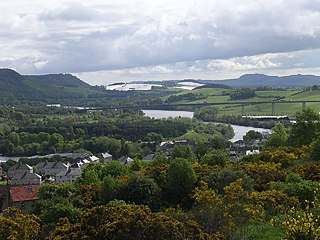| |||||
| Centuries: | |||||
|---|---|---|---|---|---|
| Decades: | |||||
| See also: | List of years in Scotland Timeline of Scottish history 1306 in: England • Elsewhere | ||||
Events from the year 1306 in the Kingdom of Scotland .
| |||||
| Centuries: | |||||
|---|---|---|---|---|---|
| Decades: | |||||
| See also: | List of years in Scotland Timeline of Scottish history 1306 in: England • Elsewhere | ||||
Events from the year 1306 in the Kingdom of Scotland .
unknown date

Robert I, popularly known as Robert the Bruce, was King of Scots from 1306 to his death in 1329. Robert was one of the most famous warriors of his generation and eventually led the Kingdom of Scotland during the First War of Scottish Independence against England. He fought successfully during his reign to regain Scotland's place as an independent country and is now revered in Scotland as a national hero.
Year 1306 (MCCCVI) was a common year starting on Saturday of the Julian calendar.

The Wars of Scottish Independence were a series of military campaigns fought between the Kingdom of Scotland and the Kingdom of England in the late 13th and early 14th centuries.

The Battle of Methven took place at Methven, Scotland on 19 June 1306, during the Wars of Scottish Independence. The battlefield was researched to be included in the Inventory of Historic Battlefields in Scotland and protected by Historic Scotland under the Scottish Historical Environment Policy of 2009, but was excluded due to the uncertainty of its location.
John Comyn III of Badenoch, nicknamed the Red, was a leading Scottish baron and magnate who played an important role in the First War of Scottish Independence. He served as Guardian of Scotland after the forced abdication of his uncle, King John Balliol, in 1296, and for a time commanded the defence of Scotland against English attacks. Comyn was stabbed to death by Robert the Bruce before the altar at the church of the Greyfriars at Dumfries.

The First War of Scottish Independence was the first of a series of wars between English and Scottish forces. It lasted from the English invasion of Scotland in 1296 until the de jure restoration of Scottish independence with the Treaty of Edinburgh–Northampton in 1328. De facto independence was established in 1314 at the Battle of Bannockburn. The wars were caused by English kings attempting to establish their authority over Scotland while Scots fought to keep English rule and authority out of Scotland.

Isabella MacDuff, Countess of Buchan was a significant figure in the Wars of Scottish Independence.
Robert de Brus, 6th Lord of Annandale, jure uxoris Earl of Carrick (1252–1292), Lord of Hartness, Writtle and Hatfield Broad Oak, was a cross-border lord, and participant of the Second Barons' War, Ninth Crusade, Welsh Wars, and First War of Scottish Independence, as well as father to the future king of Scotland Robert the Bruce.

Sir Simon Fraser of Oliver and Neidpath was a Scottish knight who fought in the Wars of Scottish Independence, for which he was hanged, drawn, and quartered in 1306.

Clan Bruce is a Lowlands Scottish clan. It was a Royal House in the 14th century, producing two kings of Scotland, and a disputed High King of Ireland, Edward Bruce.
Events from the 1300s in England.
Christian or Christina Bruce, also known as Christian or Christina de Brus, was a daughter of Marjorie, Countess of Carrick, and her husband, Robert de Brus, jure uxoris Earl of Carrick, as well as a sister of Robert the Bruce, King of Scots. It is presumed that she and her siblings were born at Turnberry Castle in Carrick.
Nigel de Brus was a younger brother of King Robert I. Born at Carrick, Ayrshire, Scotland, he was a son of Robert de Brus, 6th Lord of Annandale and Margaret, Countess of Carrick. He supported his older brother in the struggle for the crown of Scotland and fought in the Wars of Scottish Independence.
Alexander de Brus, Dean of Glasgow, was a younger brother of King Robert I of Scotland, who supported his brother in the struggle for the crown of Scotland. He was captured by forces at Loch Ryan, Galloway, Scotland and later executed by the English.
Sir Christopher Seton (1278–1306), also known as Christopher de Seton, was a 13th-century noble, who held lands in England and Scotland. He was a supporter of Robert the Bruce and obtained Robert's sister's hand in marriage. Present during the killing of John Comyn, Lord of Badenoch at Greyfriars Church, Dumfries, he also killed Sir Robert Comyn, who had rushed to Badenoch's aid. Seton was captured at Loch Doon Castle and executed at Dumfries in 1306.
Sir John de Cambo was a Scottish knight who took part in the War of Scottish Independence, as a supporter of Robert de Brus.
Sir David de Inchmartin was a Scottish knight who took part in the War of Scottish Independence, as a supporter of Robert de Brus. He was captured and later executed by the English in 1306
Sir John de Seton was a knight who took part in the War of Scottish Independence, as a supporter of Robert de Brus. He held lands in England and Scotland.
Sir Bernard de Monte Alto was a Scottish knight who took part in the War of Scottish Independence, as a supporter of Robert de Brus.
Sir Alexander Scrymgeour was a Scottish knight who took part in the War of Scottish Independence, as a supporter of Robert de Brus. He was constable of Dundee and Scottish standard bearer who was captured and later executed by the English in 1306.